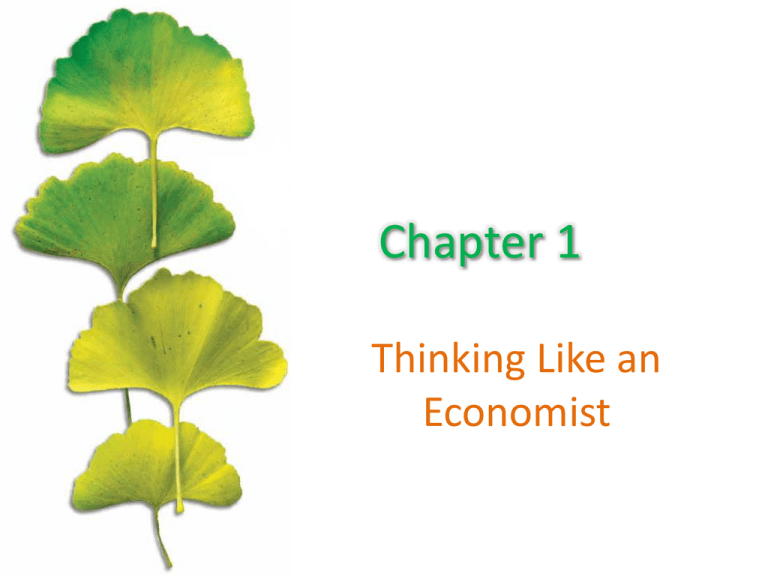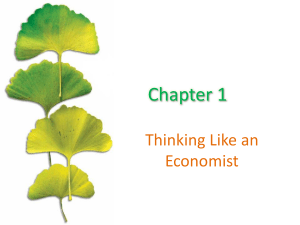
Chapter 1
Thinking Like an
Economist
Chapter Outline
•
•
•
•
•
•
The Cost-Benefit Approach to Decisions
The Role of Economic Theory
Common Pitfalls in Decision Making
Using Marginal Benefit and Marginal Cost Graphically
The Invisible Hand
Would Parents want their Daughter or Son to Marry
Homo Economicus?
• The Economic Naturalist
• Positive Questions and Normative Questions
• Microeconomics and Macroeconomics
©2015 McGraw-Hill Education. All Rights Reserved.
2
The Cost-Benefit Approach
• If the benefit of an activity exceeds its cost, do
it.
• Reservation price of activity x: the price at
which a person would be indifferent between
doing x and not doing x.
©2015 McGraw-Hill Education. All Rights Reserved.
3
Common Pitfalls in Decision Making
• Ignoring Implicit Costs
• Failing to Ignore Sunk Costs
• Measuring Costs and Benefits as
Proportions Rather than Absolute Dollar
Amounts
• Failure to Understand the AverageMarginal Distinction
©2015 McGraw-Hill Education. All Rights Reserved.
4
Pitfall #1: Ignoring Implicit Costs
• If doing activity x means not being able to do
activity y, then the value to you of doing y is
an opportunity cost of doing x.
• In other words, the opportunity cost is the
value of all that must be sacrificed to do the
activity.
©2015 McGraw-Hill Education. All Rights Reserved.
5
Pitfall #2: Failing to Ignore Sunk Costs
• An opportunity cost may not seem to be a
relevant cost when in reality it is.
• On the other hand, sometimes an expenditure
may seem relevant when in reality it is not.
– Sunk costs: costs that are beyond recovery at the
moment a decision is made.
– These costs should be ignored.
©2015 McGraw-Hill Education. All Rights Reserved.
6
Pitfall #3: Measuring Costs and
Benefits as Proportions Rather Than
Absolute Dollar Amounts
• When comparing costs and benefits, always
use absolute dollar amounts, not proportions.
©2015 McGraw-Hill Education. All Rights Reserved.
7
Pitfall #4: Failure to Understand the
Average-Marginal Distinction
• Compare the benefit and cost of an additional
unit of activity.
– Marginal cost: the increase in total cost that results
from carrying out one additional unit of activity
– Marginal benefit: the increase in total benefit that
results from carrying out one additional unit of
activity
• Keep increasing the level of an activity as long as
its marginal benefit exceeds its marginal cost.
©2015 McGraw-Hill Education. All Rights Reserved.
8
Figure 1.1: The Optimal Quality of
Conversation
©2015 McGraw-Hill Education. All Rights Reserved.
9
The Invisible Hand
• Unaware of the effects of their actions, selfinterested consumers often act as if driven by
what Adam Smith called an invisible hand to
produce the greatest social good.
• External cost of an activity: a cost that falls on
people who are not directly involved in the
activity.
©2015 McGraw-Hill Education. All Rights Reserved.
10
Would Parents Want Their Daughter or
Son to Marry Homo Economicus?
• The stereotypical decision maker in the selfinterest model is given the label Homo
Economicus, or “economic man”
• Homo Economicus only cares about personal
material costs and benefits.
• Self-interest is one of the most important
human motives, but it is not the only
important motive.
©2015 McGraw-Hill Education. All Rights Reserved.
11
The Economic Naturalist
• An economic naturalist sees the mundane
details of ordinary existence in a sharp new
light—economics is around us everywhere.
©2015 McGraw-Hill Education. All Rights Reserved.
12
Positive Questions and Normative
Questions
• Normative question: a question about what
policies or institutional arrangements lead to
the best outcomes.
• Positive question: a question about the
consequences of specific policies or
institutional arrangements.
©2015 McGraw-Hill Education. All Rights Reserved.
13
Microeconomics and Macroeconomics
• Microeconomics: the study of individual
choices and the study of group behavior in
individual markets
• Macroeconomics: the study of broader
aggregations of markets
©2015 McGraw-Hill Education. All Rights Reserved.
14







